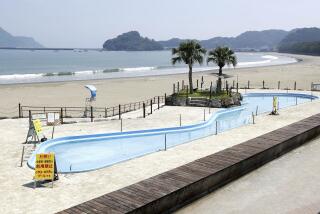Japan tunnel disaster: Weak bolts suspected, other tunnels probed
- Share via
Aging bolts could be to blame for the deadly collapse of a tunnel west of Tokyo, a highway maintenance executive told reporters Monday after nine people lost their lives to the weekend disaster.
Tons of concrete panels tumbled onto cars in the Sasago tunnel on Sunday morning, crushing and trapping vehicles underneath. The disaster stunned a nation that relies heavily on tunnels to navigate its steep terrain and has been credited as a leader in tunnel safety.
When it comes to tunnel sprinklers to stop fires, for instance, “they’ve been ahead of the game compared to Europe, the U.S. and a lot of North America,” said Fathi Tarada, managing director of Mosen Limited, a British consulting company.
The accident is still under investigation, but worn ceiling bolts are suspected to be the cause, Central Nippon Expressway Company maintenance executive Ryoichi Yoshikawa told Japanese media.
A routine inspection in September showed no problems, but Yoshikawa admitted that inspectors didn’t tap bolts with a hammer, a way of detecting irregularities that can’t be spotted by eye. The bolts did not appear to have been replaced since the highway tunnel first opened in 1977, Yoshikawa said.
Scores of other tunnels are now under investigation after the devastating collapse. The Japanese transportation ministry ordered the probes for all tunnels that share the same design, which features a hanging ceiling suspended by metal rods from the top of the tunnel.
“If those rods fail, that’s the end of the game,” said Tarada, who had seen a purported drawing of the tunnel passed along by others in the World Road Assn. “When you have a piece of metal that you’re constantly pulling and prodding, eventually the risk is it’s going to fail through fatigue.”
Earthquakes also shake the area, piling more pressure onto the metal parts. A 4.9-magnitude quake struck near Tokyo several days before the disaster.
Aging infrastructure has been a nagging worry for Japan after building blitzes. Earlier this year the Nikkei newspaper warned of a “slow disaster” ahead, arguing that the government had failed to keep roads and bridges in repair, instead plowing money into new projects.
While Japanese infrastructure spending has been historically hefty compared to nations such as the United States, experts warn that Japan’s hilly terrain, frequent natural disasters and dense population put added stresses on infrastructure compared with other developed countries.
Serious accidents spurred earlier strides in Japanese tunnel safety: A 1979 blaze in the Nihonzaka tunnel that killed seven people prompted new standards to help rescue people during emergencies, including information boards inside tunnels and lighting cables resistant to fire. The most deadly such disaster in recent years was in 1996, when a massive rock tumbled in the Toyohama tunnel, killing 20 people.
ALSO:
Israel’s E1 settlement plan draws European backlash
Power struggle paralyzes South Africa’s ruling ANC party
Clinton issues new warning to Syria on use of chemical weapons
More to Read
Sign up for Essential California
The most important California stories and recommendations in your inbox every morning.
You may occasionally receive promotional content from the Los Angeles Times.










